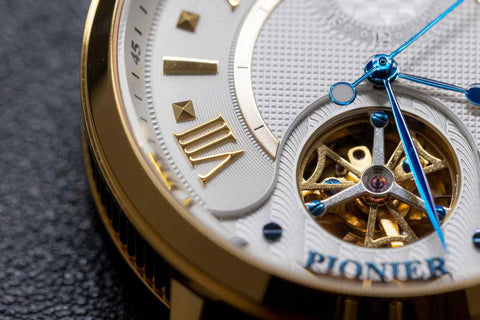Watches have been around for centuries and they’ve become a timeless accessory for both men and women. In addition to their visual appeal, they’ve become a highly functional tool that allows for easy and efficient timekeeping. If you’ve become interested in the world of horology, you should know that there is a lot more depth in them than first meets the eye. From complicated compilations to modern designs, timepieces showcase a high level of precision, passion and determination. In this blog post, we’ve outlined 10 of the most interesting facts about watches that you probably don’t know.
Tufina: automatic Boston by Pionier Germany.
Watches only had the hour hand
Timekeeping devices have been around for averylong time. Watches were invented around the 15th and 16th century, and back then, they only had the hour hands. It was only in the 17th century that the minute hand was introduced. From that point forward, watch manufacturers became more and more competitive in the quest of producing compact timepieces that ensured easy portability.
Accuracy changes among movement types
Quartz watches have proven to be slightly more accurate than mechanical watches. That’s because mechanical timepieces can gain or lose a few seconds over time due to the effect of gravity. Nevertheless, watches with quartz movements can be affected by temperature and battery life. Both options have their own strengths and downsides, so choosing between them is often a matter of personal preference.
The most complicated pocket watch
For a long time (until September 2015), Patek Philippe was renowned for manufacturing the most complicated pocket mechanical watch in 1989. The Caliber 89 is made from 18-carat gold and a total of 1,728 components. This timepiece had 24 hands and 33 special features. It’s probably one of the most unique pocket watches in the world, equipped with a thermometer and a star chart as well. However, later on Vacheron Constantin came up with an even more complicated timepiece. This mechanical watch (model 57260) features 57 complications and is made with over 2800 components.
“Happy time” faces
When displayed in shops, most watches are often pre-set to show the time at 10 minutes past 10 o’clock or 10 minutes to 2 o’clock. This is also known as the “happy time”, because it allows for the watch hands to create an appearance that mimics the look of a smiley face. This tactic is used to tap into the buyers subconscious and elevate their food, which subliminal encourages them to make a purchase.
Tufina: see-through Lady Butterfly by Theorema Germany.
Wristwatches were first designed for women
Back when pocket watches were popular, wristwatches were not a thing. Historical accounts show that men relied on pocket watches up until WW1. Wristwatches on the other hand were designed for women. Only after the war did men begin to wear them as well, due to their convenience and practicality. This marked an important shift in watchmaking history, as wristwatches became an everyday accessory that would continue to hold its significance for years to come.
A system that has endures ages
One of the most fascinating facts about watches is that their inner workings have pretty much remained the same for more than two centuries. A wheel of four gears is powered by a tightly wound spring. The hands are attached to these gears and just like that, this simple and yet fascinating system has become a solid foundation for the production of timepieces for centuries.
Watch repairing is becoming a dying craft
This rare but valuable profession has seen a huge decline in recent years. Over the last six decades, the number of qualified watchmakers in the US has dropped from 60,000 to about 5,000. However, this fading artform must be preserved, as it is one of the oldest in history. At Tufina Watches, we’ve created a strong bond to this age-old tradition, that’s why we do our best to guarantee exceptional watch repair services for our clients.

Queen Elizabeth II after her Coronation, London, June 1953.
The smallest mechanism in the world
If you’ve ever seen a picture of Queen Elizabeth II's coronation, you might have noticed a small and gorgeous watch on her wrist. That was the Jaeger-LeCoultre Caliber 101. This magnificent diamond timepiece is known for having the smallest movement in the world. A hand-wound timepiece that weighs less than one gram. It has remained the smallest mechanical watch and also one of the most historically influential!
The first modern chronograph
Louis Moinetin is credited with inventing the first chronograph in 1816. This timepiece was called a “Compteur de Tierces” and it was fully completed in 1816. This fascinating watch was capable of measuring the 60th of a second and it was also the first high-frequency timepiece with 216,000 VPH. in 1844, Adolphe Nicole updated this version including a re-setting feature which allowed for successive measurements. Inspired by the magnificent technological value and precision of these timepieces, we’ve created our own Tufina chronograph, the sleek and modern Tirona.

Abraham-Louis Breguet’s Tourbillon.
The most famous watch type in the world
The tourbillon, or "whirlwind" in French, is undoubtedly the most prominent watch feature in the horology scene. Abraham-Louis Breguet created it more than 200 years ago. He theorized that gravity affects the accuracy of pocket watches that sit upright in a pocket all day only causing the ticking balance spring to go in one direction. Thus, he came up with the idea of a tourbillon, which rotates the entire balance assembly 360 degrees per minute inside a cage, evening out the negative effects of gravity throughout the course of the spring.








Leave a comment